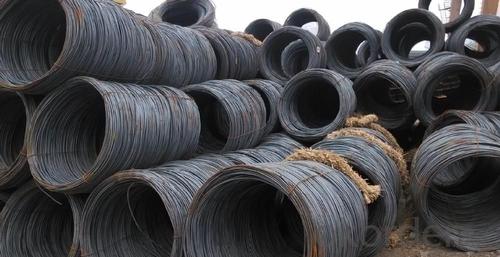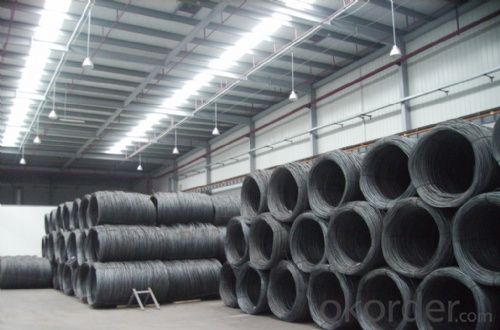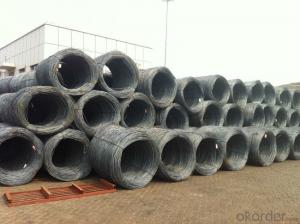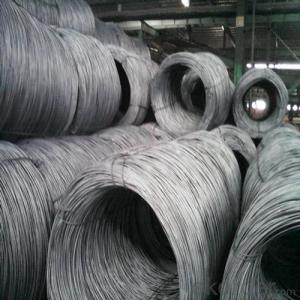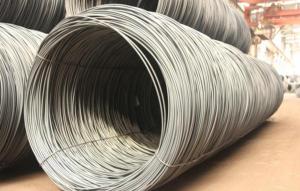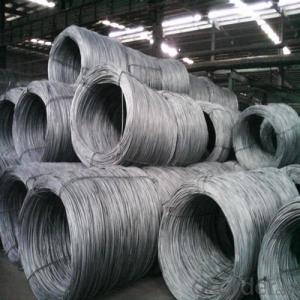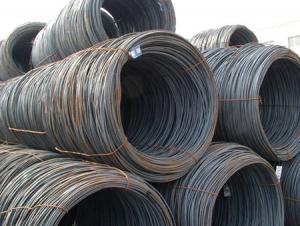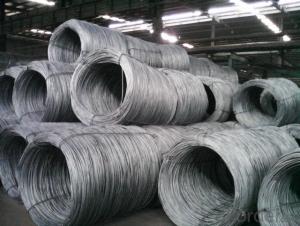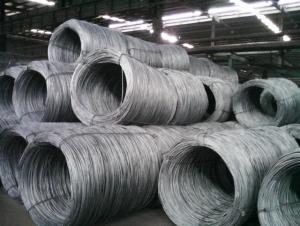SAE1008 Steel Wire Rod
- Loading Port:
- China Main Port
- Payment Terms:
- TT OR LC
- Min Order Qty:
- -
- Supply Capability:
- -
OKorder Service Pledge
OKorder Financial Service
You Might Also Like
Specifications of Wire Rod SAE1008B:
Grade: SAE1008B Standard: ASTM
Diameter: 5.5mm, 6.5mm, 7mm, 8mm
Alloy or Not: Alloy
Technique: Hot Rolled Place of Origin: China Mainland
Chemical Composition:
Please kindly find our chemistry of our material based on SAE1008B as below for your reference:
Grade | Chemical Composition (%) | |||||
C | Mn | S | P | Si | B | |
SAE1008B | 0.10max | 0.32max | 0.045max | 0.040max | 0.30max | 0.0008min |
Mechanical properties | ||||||
Yield strength(N/mm2) | Tensile strength(N/mm2) | Elongation (%) | ||||
≥195 | 350-380 | ≥32 | ||||
Usage and Applications of Wire Rod SAE1008B:
After hot-rolled the products shaped into coil and delivery as finished product, including round, square,rectangular, hexagonal and so on. Since most of the products are round, it is generally called wire rod. Carbon steel wire rod is widely used in construction and manufacturing. Carbon steel wire rod is mainly used for reinforcement of reinforced concrete and welded structure or reprocessed (roberts , nail, etc.) materials, especially used to produce wire drawing, welding electrode, nails, spring, electronic, precise machinery parts and so on.
Packaging & Delivery of Wire Rod SAE1008B:
Packaging Detail: products are packed in coil and then shipped by container or bulk vessel
Each coil weight: About 2.05MT
Delivery Detail: within 45 days after received deposit or LC.
Label: to be specified by customer, generally, each bundle has 1-2 labels
Trade terms: FOB, CFR, CIF
*If you would like to get our price, please inform us the size, standard/material and quantity. Thank you very much for your attention.
- Q: What are the different types of steel wire rod coatings used for increased strength?
- To enhance the strength of steel wire rods, various coatings are commonly applied. These coatings aim to improve the mechanical properties and overall performance of the wire rod. One frequently used coating for increased strength is zinc coating, also known as galvanizing. This process involves immersing the wire rod in molten zinc, resulting in a protective layer that offers excellent corrosion resistance. Furthermore, the zinc coating acts as a barrier, preventing direct contact with corrosive substances and thereby increasing the wire rod's strength and durability. Another coating option for increased strength is polymer coating. This protective layer is applied to the wire rod through methods like extrusion or electrostatic spraying. It provides resistance against abrasion, impact, and corrosion while also enhancing flexibility and fatigue resistance, ultimately improving the wire rod's overall strength. Epoxy coatings are also commonly used to increase strength. These coatings, composed of a mixture of resin and hardener, are applied to the wire rod's surface through electrostatic deposition. They offer exceptional adhesion and chemical resistance, making the wire rod stronger and more corrosion-resistant. Additionally, ceramic coatings are utilized to enhance the strength of steel wire rods. These coatings are typically applied through thermal spraying techniques, where a ceramic material is heated and propelled onto the wire rod's surface. Ceramic coatings provide exceptional hardness, wear resistance, and high-temperature resistance, making the wire rod more robust and suitable for demanding applications. In conclusion, zinc coating, polymer coating, epoxy coating, and ceramic coating are among the various types of steel wire rod coatings used to increase strength. Each of these coatings offers distinct advantages in terms of corrosion resistance, flexibility, adhesion, and wear resistance, ultimately enhancing the wire rod's strength and durability.
- Q: How does steel wire rod behave under different temperature conditions?
- Steel wire rod behaves differently under different temperature conditions. At lower temperatures, steel wire rod tends to become more brittle and prone to fracturing. This is because the cold temperatures cause the metal to contract, reducing its ductility and making it more susceptible to breaking under stress. On the other hand, at higher temperatures, steel wire rod becomes more malleable and easier to bend or shape. This is due to the expansion of the metal as it heats up, which increases its ductility and allows it to withstand greater deformation without fracturing. However, it is important to note that extreme temperatures can have adverse effects on steel wire rod. At extremely low temperatures, such as those found in cryogenic environments, the steel may undergo a phase transformation known as the ductile to brittle transition, where it becomes extremely brittle and prone to sudden failure. Similarly, at extremely high temperatures, steel wire rod may lose its strength and integrity, as the elevated temperatures can cause the metal to soften and deform. The exact temperature at which this occurs depends on the specific type of steel and its composition. In summary, steel wire rod behaves differently under different temperature conditions. It becomes more brittle and prone to fracturing at lower temperatures, while it becomes more malleable and easier to shape at higher temperatures. However, extreme temperatures can have detrimental effects on the steel's properties, leading to brittleness at low temperatures and loss of strength at high temperatures.
- Q: How is steel wire rod used in the manufacturing of wire for construction reinforcement grids?
- Steel wire rod is a primary raw material used in the manufacturing of wire for construction reinforcement grids. It serves as the starting point for the wire production process. The steel wire rod is first drawn through a series of dies to reduce its diameter and increase its length, resulting in a smoother and more uniform wire. This wire is then further processed and formed into the desired shape and size to create the wire mesh used in construction reinforcement grids. By providing the necessary strength and durability, the steel wire rod ensures the wire mesh can effectively reinforce concrete structures, enhancing their structural integrity and longevity.
- Q: How are steel wire rods used in the manufacturing of screws and bolts?
- Steel wire rods are used in the manufacturing of screws and bolts as they provide the raw material for shaping and forming these fasteners. The rods are typically cold drawn or hot rolled to produce the required diameter and length for the specific screw or bolt size. They are then cut, threaded, and heat-treated to enhance their strength and durability. Finally, the rods are further processed to create the screw or bolt head, ensuring a secure and reliable fastening solution.
- Q: What are the environmental benefits of recycling steel wire rod?
- Recycling steel wire rod provides various benefits to the environment. The foremost advantage is the conservation of natural resources. By recycling steel, we can decrease the necessity for extracting and mining iron ore, which is the primary raw material utilized in steel production. This lessens the environmental impact of mining activities, which encompass deforestation, habitat destruction, and soil erosion. Moreover, recycling steel wire rod aids in reducing energy consumption and greenhouse gas emissions. The production of steel from recycled materials requires considerably less energy compared to the production from virgin materials. Additionally, the recycling process emits fewer greenhouse gases, such as carbon dioxide, in comparison to manufacturing steel from scratch. By recycling steel wire rod, we can help mitigate climate change and diminish our carbon footprint. Furthermore, recycling steel wire rod assists in waste reduction and conserves landfill space. Steel is a long-lasting material that can be recycled indefinitely without losing its properties. By recycling steel wire rod, we can divert this material from ending up in landfills, where it would occupy valuable space and contribute to pollution. Additionally, recycling steel wire rod diminishes the necessity for new steel production, which can result in waste generation and environmental pollution during the manufacturing process. Lastly, recycling steel wire rod aids in safeguarding ecosystems and wildlife. Mining activities for iron ore extraction can have devastating effects on ecosystems, including forest destruction, water source contamination, and disruption of wildlife habitats. By reducing the demand for new steel production through recycling, we can minimize the negative impacts on ecosystems and preserve biodiversity. In conclusion, recycling steel wire rod presents numerous environmental benefits, such as the conservation of natural resources, reduction in energy consumption and greenhouse gas emissions, waste reduction, and protection of ecosystems and wildlife. By opting to recycle steel wire rod, we can contribute to a more sustainable and eco-friendly future.
- Q: What are the common production processes for einsteinium-coated steel wire rod?
- The common production processes for einsteinium-coated steel wire rod typically involve a combination of metallurgical techniques and surface coating methods. The steel wire rod undergoes initial processing steps such as casting, hot rolling, and drawing to achieve the desired dimensions and mechanical properties. Subsequently, the wire rod is subjected to a surface treatment process to apply the einsteinium coating. This coating can be achieved through various methods including physical vapor deposition (PVD), chemical vapor deposition (CVD), or electroplating. The specific production processes may vary based on the intended application and requirements of the einsteinium-coated steel wire rod.
- Q: How does the elongation of steel wire rod vary with different heat treatment processes?
- The elongation of steel wire rod is influenced by different heat treatment processes. Heat treatment involves subjecting the steel wire rod to specific temperatures and cooling rates to alter its structure and properties. One common heat treatment process for steel wire rod is annealing. During annealing, the wire rod is heated to a high temperature and then slowly cooled. This process relieves internal stresses and allows for the formation of a more uniform and ductile microstructure. As a result, the elongation of the steel wire rod typically increases after annealing. The increased elongation is due to the reduction in brittleness and the improved ability of the material to deform without fracturing. On the other hand, another heat treatment process called quenching and tempering involves rapid cooling followed by reheating and slow cooling again. Quenching hardens the steel wire rod, making it stronger and more resistant to deformation. However, this process can also make the material more brittle, reducing its elongation. The subsequent tempering process relieves some of the brittleness while maintaining the strength, resulting in a moderate elongation. In summary, the elongation of steel wire rod varies with different heat treatment processes. Annealing increases elongation by improving ductility and reducing brittleness, while quenching and tempering can result in a moderate elongation by balancing strength and brittleness. The specific heat treatment process chosen for steel wire rod depends on the desired mechanical properties and performance requirements for its intended application.
- Q: What are the common defects that can occur during the processing of steel wire rod?
- During the processing of steel wire rod, various defects can arise, impacting the wire rod's properties and performance. Identifying and addressing these defects is of utmost importance. 1. Surface defects, such as scratches, pits, cracks, and scale, can significantly affect the wire rod's appearance and quality. These defects occur due to mishandling, improper rolling, or cooling processes. 2. Internal defects encompass inclusions, voids, and segregation. Inclusions refer to non-metallic particles or impurities weakening the wire rod. Voids are internal cavities that compromise its strength and structural integrity. Segregation involves uneven distribution of alloying elements, resulting in inconsistent mechanical properties along the wire rod's length. 3. Dimensional defects include variations in diameter, ovality, and straightness. These defects occur due to inadequate rolling, cooling, or handling processes, resulting in wire rods that fail to meet required specifications. 4. Decarburization is the loss of carbon from the wire rod's surface during heating or annealing processes. This loss diminishes its strength and hardness, impacting performance in applications requiring high strength. 5. Surface contamination can transpire during the processing of steel wire rod, resulting in foreign materials like oil, grease, dirt, or oxide scales. These contaminants adversely affect the wire rod's surface quality and may cause issues during subsequent processing or applications. To minimize these defects, implementing proper quality control measures throughout the production process is crucial. This involves using high-quality raw materials, employing effective rolling and heat treatment processes, and conducting regular inspections and testing to promptly identify and rectify any defects that arise.
- Q: What are the common production processes for palladium-coated steel wire rod?
- The common production processes for palladium-coated steel wire rod include wire drawing, heat treatment, cleaning, palladium coating, and final inspection.
- Q: What are the common production processes for neon-coated steel wire rod?
- The common production processes for neon-coated steel wire rod typically include wire drawing, cleaning and coating, curing, and cutting.
Send your message to us
SAE1008 Steel Wire Rod
- Loading Port:
- China Main Port
- Payment Terms:
- TT OR LC
- Min Order Qty:
- -
- Supply Capability:
- -
OKorder Service Pledge
OKorder Financial Service
Similar products
Hot products
Hot Searches
Related keywords



